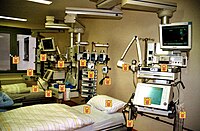
Photo from wikipedia
Intensive care unit (ICU)-acquired infection is a common cause of poor prognosis of sepsis in the ICU. However, sepsis-associated ICU-acquired infections have not been fully characterized. The study aims to… Click to show full abstract
Intensive care unit (ICU)-acquired infection is a common cause of poor prognosis of sepsis in the ICU. However, sepsis-associated ICU-acquired infections have not been fully characterized. The study aims to assess the risk factors and develop a model that predicts the risk of ICU-acquired infections in patients with sepsis. Methods We retrieved data from the Medical Information Mart for Intensive Care (MIMIC) IV database. Patients were randomly divided into training and validation cohorts at a 7:3 ratio. A multivariable logistic regression model was used to identify independent risk factors that could predict ICU-acquired infection. We also assessed its discrimination and calibration abilities and compared them with classical score systems. Results Of 16,808 included septic patients, 2,871 (17.1%) developed ICU-acquired infection. These patients with ICU-acquired infection had a 17.7% ICU mortality and 31.8% in-hospital mortality and showed a continued rise in mortality from 28 to 100 days after ICU admission. The classical Systemic Inflammatory Response Syndrome Score (SIRS), Sequential Organ Failure Assessment (SOFA), Oxford Acute Severity of Illness Score (OASIS), Simplified Acute Physiology Score II (SAPS II), Logistic Organ Dysfunction Score (LODS), Charlson Comorbidity Index (CCI), and Acute Physiology Score III (APS III) scores were associated with ICU-acquired infection, and cerebrovascular insufficiency, Gram-negative bacteria, surgical ICU, tracheostomy, central venous catheter, urinary catheter, mechanical ventilation, red blood cell (RBC) transfusion, LODS score and anticoagulant therapy were independent predictors of developing ICU-acquired infection in septic patients. The nomogram on the basis of these independent predictors showed good calibration and discrimination in both the derivation (AUROC = 0.737; 95% CI, 0.725–0.749) and validation (AUROC = 0.751; 95% CI, 0.734–0.769) populations and was superior to that of SIRS, SOFA, OASIS, SAPS II, LODS, CCI, and APS III models. Conclusions ICU-acquired infections increase the likelihood of septic mortality. The individualized prognostic model on the basis of the nomogram could accurately predict ICU-acquired infection and optimize management or tailored therapy.
Journal Title: Frontiers in Cellular and Infection Microbiology
Year Published: 2022
Link to full text (if available)
Share on Social Media: Sign Up to like & get
recommendations!